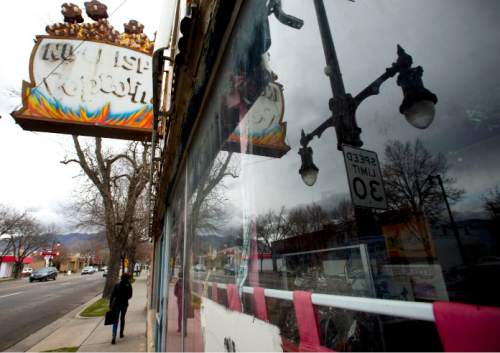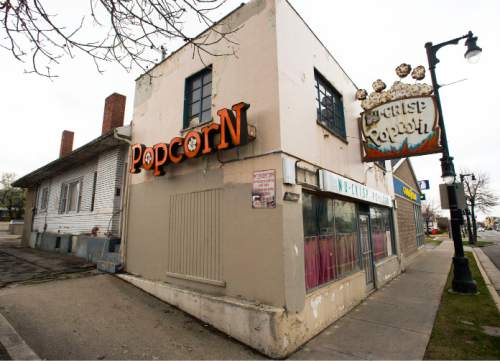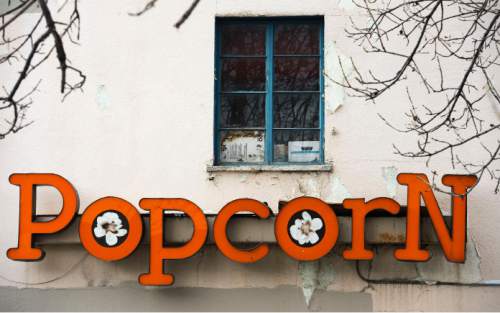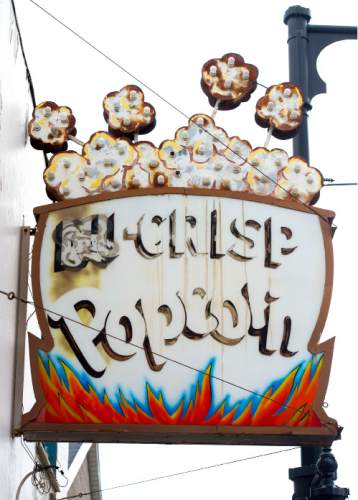This is an archived article that was published on sltrib.com in 2015, and information in the article may be outdated. It is provided only for personal research purposes and may not be reprinted.
If you peek through the windows of the seemingly abandoned Nu-Crisp Popcorn Co. building in Sugar House, you can see taffy hanging from the puller, frozen in time.
The popcorn and candy shop frequented by families for a half-century sits at 960 E. 2100 South, but what's become of Nu-Crisp is a bit of a mystery.
The shop was founded by George and Leone Kelly in 1932. For many, it was the favorite spot for a "special treat" at a time when money was tight, eating out was rare and many movie theaters didn't sell snacks.
"Our big treat was to go to Nu-Crisp," said Kathleen Harmon Gardner, who grew up in Sugar House in the late 1950s. "It was an occasion to go down there; we'd get dressed up and go down on the bus."
Gardner remembers the store being somewhat untidy, with machines and popcorn everywhere, she said.
"I drive by now, and sometimes I'm stopped at a stoplight and see those dirty windows and see the big mess inside and it just makes me sad," Gardner said.
The Kellys kept the store alive through the Great Depression, World War II and occasional corn scarcities, according to a 1982 Deseret News article.
"The first day we opened we worked from 10 a.m. to 10 p.m. and made a dime. The first week we only took in $8, and our rent alone cost $1 a day," George Kelly told the News.
Nu-Crisp sold 33 flavors of popcorn, including cheese corn and strawberry corn, though most patrons remember buying original or caramel in bulk bags big enough for the whole family.
The store was originally located next to Marlo Theatre, about a block away from where it sits now. At the time, The Marlo didn't sell snacks or drinks.
In 1946, the Kellys moved the shop to a house across the street. And in 1950, the family built up a two-story store front and moved into the residence behind it.
Lynne Olson, a former member of the Sugar House Community Council and a historian, spent months researching Nu-Crisp's story trying to figure out what happened to the once-favorite family shop.
"The really short answer is that Nu-Crisp stopped being Nu-Crisp when the original owners, the Kellys, decided it was time to retire," Olson said.
Some have suggested the decline of drive-in movie theaters is to blame for Nu-Crisp's demise, and selling popcorn as a novelty probably came to a head when microwave popcorn was invented.
From 1970 to the mid-1990s, ownership of Nu-Crisp changed hands several times. One owner, Harold Jensen, said it was "a tremendous business" in the 1970s.
He sold the store's equipment to Margene Sorenson, but he said he retained the Nu-Crisp Popcorn name. He now owns a uniform company called Nu*Crisp Image Apparel, based in Denver. Sorenson also bought the building from the Kellys.
The name NuCrisp, without the hyphen, may be seen on popcorn bags in grocery stores along the Wasatch Front. Brian Squire, once affiliated with Nu-Crisp Popcorn, kept the name. His company, J. Morgan Confections, sells its popcorn to distributors, along with its large candy inventory.
But the name is the only connection, he said; the popcorn won't necessarily taste the same. Where the popcorn recipes are, none could say.
Most who remember the Sugar House store harbor only fond memories and affection for the iconic sign, with its popcorn spilling over a pot. But the sign was not the store's original — it was designed and installed in the 1970s under a short-time manager.
The popcorn at the top once had a literal sparkle, Olson said. With the years, the sign has rusted and it now gives the illusion that the popcorn has burnt.
The place is still owned by Sorenson, who in 2013 told Olson she hoped she could revive the store someday into a popcorn and candy museum.
But Olson, who has served on the zoning councils for Sugar House, said there are "enormous obstacles for her to get it reopened." One hurdle: the building has no parking associated with it, according to Olson.
Olson is part of a volunteer team trying to save the Nu-Crisp sign, along with a handful of other historic signs in Sugar House. The committee has come up with a new plan — to prevent the sign from falling into disrepair and literally off the building — that should unfold this summer.













